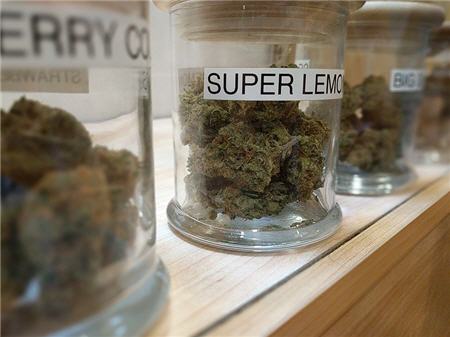Cannabis decriminalization. Cannabis legalization. Cannabis
normalization? Not even close.
In Canada, thousands of Canadians
took to the streets on April 20
th to celebrate the first “Cannabis 420” since Canada officially legalized the recreational consumption of cannabis. Cannabis users were ‘coming out of the closet’, meaning instead of having to grow cannabis
in their closets and consume it surreptitiously, (adult) Canadians were supposed to be able to consume cannabis without recriminations or hassles.
It hasn’t worked out that way.
.png)
Both the federal and provincial governments have shown themselves to be reluctant partners in post-Prohibition cannabis legalization. This is despite the fact that cannabis is non-toxic, non-addictive, and (unlike alcohol and tobacco) cannabis alleviates health problems rather than causing them. Yet federally, the government continues to bombard Canadians with commercials that deviously
imply that cannabis is somehow dangerous. It produces no facts to support these insinuations, since there is no legitimate medical evidence that cannabis use is any sort of health-hazard.
The second phase of cannabis legalization (normalization) in Canada is coming in October 2019: the legalization of cannabis “edibles” and other cannabis-infused products. However, a recent
Stockhouse article noted the roadblocks that the federal government is putting in the way of commercializing these products, in draft legislation.
Companies wanting to produce (for example) cannabis-infused beverages will have to quarantine such production by constructing entirely separate facilities for the manufacturing of these products. This will not only significantly delay the introduction of these value-added cannabis products into the Canadian marketplace, it will significantly ratchet up production costs – and consumer prices.
The government should be
encouraging Canadians to shift from the consumption of toxic/addictive alcohol products, which are extremely dangerous in combination with many prescription drugs. In contrast, non-toxic cannabis is not “contra-indicated” with respect to any known pharmaceutical. Yet the unnecessarily restrictive framework in the draft legislation would make it difficult for cannabis-infused products to compete with alcohol consumption in terms of price.
Then there are the provincial and territorial governments. In most jurisdictions, Canadians are still being forced to turn to black market cannabis sources for recreational cannabis because of inadequate retail access and/or over-taxation. As a result, 72% of recreational cannabis sales in Canada
in 2019 are still expected to occur in the black market. Legalization, but not normalization.
Both federal and provincial/territorial governments
claim that their primary motivation in legalizing cannabis was to put an end to black market commerce. This is so Canadians could consume cannabis that was regulated and inspected (like other consumer products) to ensure that these cannabis products were free from contaminants like chemicals and microbial organisms. Clearly, however, the actions of these governments speak louder than words.
Then there are the policies of many public and private sector employers. Emboldened by the federal government continuing to stigmatize cannabis consumption (without evidence), many employers are prohibiting their employees from consuming cannabis
outside of working hours – again, without any supporting medical evidence for such a restriction.
Such policies are absurdly discriminatory and cannot possibly withstand challenge in the courts. However, until that happens, large numbers of working Canadians have to choose between post-Prohibition cannabis prohibition – or risk their employment.
The combined effect of all this Boogeyman propaganda, excessive regulation, excessive taxation, unreasonable restrictions on consumption, etc. is that our governments are woefully failing Canadians in normalizing cannabis usage. Our governments are woefully failing Canadian cannabis
businesses and the shareholders of those businesses through
failing to normalize cannabis commerce in a good faith manner.
In the United States, the situation is even more extreme (more absurd?). In the land that spawned the totally discredited “War on Drugs”, anti-cannabis prejudice and phobias are much more deeply entrenched.
Federally, cannabis remains equated with heroin as a Schedule 1 narcotic – the highest level of narcotic prohibition in the United States. To qualify as Schedule 1, a drug must be proven to be hazardous and “without any known medicinal benefit”. In the case of cannabis, neither one of these qualifying factors is remotely applicable. Because of an even more-restrictive federal environment in the United States (and because of lingering anti-cannabis biases), state and local governments have made cannabis consumption and cannabis commerce even more of an obstacle course than in Canada.
 (three strains of cannabis for sale in a Denver, Colorado dispensary)
(three strains of cannabis for sale in a Denver, Colorado dispensary)
Take California as an example. With a population roughly equal to all of Canada, cannabis businesses have touted the California marketplace as the Promised Land, where both legalized medicinal cannabis and legalized recreational cannabis came well ahead of the end of cannabis Prohibition in Canada. But appearances can be deceiving.
A
Leafly article paints an even more disturbing picture of county governments that are not merely failing their residents but actively opposing the will of their own voters. Of California’s 58 counties, 38 of them (roughly two-thirds) still have full Prohibition bans in place with respect to cannabis commerce: illegal to commercially cultivate, illegal to manufacture cannabis products, and illegal to retail cannabis products. This is true even in many counties in which solid majorities voted in favor of cannabis legalization.
Another 11 California counties offer “limited” cannabis commerce, and three counties are listed as being in transition. Only 6 of California’s counties (roughly 10%) have reflected the will of the State government and California voters, and fully opened up their counties to cannabis commerce.
The result of this semi-Prohibition in California is that even with its huge head-start versus Canada in normalizing cannabis commerce, only $3.7 billion of the $9.2 billion spent by Californians on cannabis in 2018 (on recreational and medicinal cannabis) occurred via legal channels, according to
Arcview/BDS Analytics. Roughly $5.5 billion (60%) was black market commerce.
While cannabis commerce spreads slowly (but unevenly) across Canada, in California, cannabis commerce and cannabis businesses are herded into a handful of fully legal enclaves. Leafly refers to this as a classic “NIMBY” scenario, but also notes that the permissive regulatory structure at the state level places much of the onus for creating a regulatory structure for cannabis commerce on county governments. Rather than wade into an industry that many of these elected officials simply don’t understand (thanks to 100 years of Prohibition), county officials are taking the easy way out: continuing
local Prohibition in what is supposed to be a fully legal state for cannabis commerce.
A previous
Forbes article noted that the situation is even worse in Massachusetts, another (supposedly) fully legal jurisdiction for both medicinal and recreational cannabis. A full 75% of
all cannabis sales in 2019 are expected to take place on the black market. In Massachusetts, the problem is more related to excessive taxes and over-regulation versus California’s problem of local Prohibition.
It must also be noted that the mainstream media has played a destructive rather than a constructive role, post-Prohibition. Instead of seeking to educate their audiences about cannabis – and help to neutralize a century of absurd anti-cannabis propaganda that these “news” sources regularly published – these multinational corporations seem more interested in perpetuating anti-cannabis mythology and frightening investors.

In Canada, mainstream media sources go out of their way to put a negative slant on the cannabis industry and cannabis commerce. Typical articles accuse the cannabis industry of “under-performing” versus pointing the finger squarely at governments for obstructing the transition toward legal cannabis commerce. In the United States, mainstream
media fearmongers prefer the approach of simply labeling the cannabis sector as “a bubble” and relentlessly comparing the cannabis sector to
cryptocurrencies, despite no similarities of any kind.
Cannabis normalization is a genie that cannot be put back into the bottle. Cannabis was criminalized for roughly 100 years for purely political reasons without any scientific/medical justification. We now know that cannabinoids, the active ingredients in the cannabis plant, are produced naturally in the human body – helping to promote and regulate human health.
For this reason, cannabis (and the cannabinoids it contains) has been shown to have therapeutic value in the treatment of thousands of medical ailments. Cannabinoids are now also considered to be a potent
health supplement.
Rather than embracing cannabis normalization and distancing themselves from 100 years of unjustified cannabis Prohibition, both governments and the mainstream media are showing far more inclination to obstruct cannabis commerce at every turn and
continuing to disseminate "fake news" about cannabis.
While post-Prohibition cannabis prohibition may not be as legally punitive as the shameful era of official cannabis Prohibition, in many ways it is even more frustrating. Cannabis is now legal in most of North America but getting your hands on legal cannabis products (and at fair/rational prices) is much easier said than done.